

Chip-8 Emulation on a SoCKit FPGA Team: Ashley Kling, Levi Oliver, Gabrielle Taylor, David Watkins Supervisor: Prof. Stephen Edwards
1 Chip-8 Emulation Overview Not your garden variety interpreted programming language
Opcodes and Instructions ▪ Chip-8 has a total of 35 instructions 00E0 - CLS 00EE - RET 0nnn - SYS addr 1nnn - JP addr 2nnn - CALL 3xkk - SE Vx, 4xkk - SNE Vx, addr byte byte 5xy0 - SE Vx, 6xkk - LD Vx, 7xkk - ADD Vx, 8xy0 - LD Vx, 8xy1 - OR Vx, 8xy2 - AND Vx, 8xy3 - XOR Vx, Vy byte byte Vy Vy Vy Vy 8xy4 - ADD Vx, 8xy5 - SUB Vx, 8xy6 - SHR Vx 8xy7 - SUBN Vx, 8xyE - SHL Vx 9xy0 - SNE Vx, Annn - LD I, Vy Vy {, Vy} Vy {, Vy} Vy addr Bnnn - JP V0, Cxkk - RND Vx, Dxyn - DRW Vx, Ex9E - SKP Vx ExA1 - SKNP Vx Fx07 - LD Vx, Fx0A - LD Vx, K addr byte Vy, nibble DT Fx15 - LD DT, Fx18 - LD ST, Fx1E - ADD I, Fx29 - LD F, Vx Fx33 - LD B, Vx Fx55 - LD [I], Fx65 - LD Vx, Vx Vx Vx Vx [I] - Unsupported - Supported - Cycle Intensive
Chip-8 Hardware Specifications - 64x32 bit display - 64B stack - 4KB memory - 16-key input - 16B register file
Keyboard Layout ▪ O – Reset ▪ P – Pause ▪ Enter – Start ▪ Keyboard Mapping 1 2 3 4 1 2 3 C Q W E R 4 5 6 D A S D F 7 8 9 E Z X C V A 0 B F
2 Emulator Layout About as nice looking as this powerpoint
Linux to SoCKit Bridge PC V0 V1 V2 V3 V4 V5 V6 V7 SP V8 V9 VA VB VC VD VE VF Note: Identical to our design in I our proposal 1-bit Sound Sound Timer CPU Channel Delay Timer Stack 64B Chip-8 Font 4K Memory Framebuffer VGA Out set (80B) 16 Key Keyboard Keyboard out Read/Write State Linux
Linux Layout Chip8 Executable Chip8 Driver Status Chip8 Printer Read/Write Instruction Verification To FPGA ioread/ iowrite Keyboard File Reader Fontset Listener - Some Instructions required an iowrite then an ioread .ch8 Keyboard file
Hardware Layout Chip8_Top CPU From Linux Arbitrator (always_ff loop) BCD RNG ALU Note: This is not a bus, all modules have their own channels 1-bit Delay Sound Sound Timer Timer Channel Stack Framebuffer Register VGA Out Memory Buffer Memory File
3 Module Design Insert something snarky here
Chip8-Top as Master Control Unit No No Yes No No If If Stage If Stage == If Stage == If 50000 > If state == chipselect Chip8_RUNNING 0 1 Stage >= 2 >= 50000 No Yes Yes Yes Yes Yes Operate on Load PC Parse Load Set stage = Do nothing into output address Instruction 0 memaddr from CPU Update Update values in values if memory write Note: Stage is incremented on each clock cycle while state == Chip8_Running and the device is not waiting for keyboard input
Framebuffer Double Buffer Buffer Arbitrator Framebuffer - The Framebuffer manages two 64x32 bit memories in an effort to reduce flicker - The arbitrator will copy the buffer over to the framebuffer only when it has been 4 CPU cycles since the last draw instruction or if it has been 10 CPU cycles since the last copy - Chip8 erases sprites by drawing them over existing pixels which can cause extreme flickering
Draw Instruction Over Multiple Cycles reg_addr1 = instruction[11:8]; reg_addr2 = instruction[ 7:4]; num_rows_written = {7'b0,stageminus16[31:7]}; mem_addr1 = num_rows_written + reg_I_readdata; mem_request = 1'b1; fb_addr_x = reg_readdata1 + ({5'b0, stageminus16[6:4]}); fb_addr_y = reg_readdata2 + ({4'b0, num_rows_written[3:0]}); fb_writedata = mem_readdata1[3'h7 - stageminus16[6:4]] ^ fb_readdata; fb_WE = (num_rows_written < {28'h0, instruction[3:0]}) & (&(stage[3:0])); bit_overwritten = (mem_readdata1[3'h7 - stageminus16[6:4]]) & (fb_readdata) & fb_WE; isDrawing = 1'b1; - The locations being drawn are a function of the stage - We need to make sure the memory has enough time to propagate, which means that we are looking at the [6:4] bits of stage for x, and [10:7] for y - 16 <= stage <= 272
Draw Instruction Over Multiple Cycles Stage: X offset WE Number of rows written … 11 10 9 8 7 6 5 4 3 2 1 0
4 Testbenches Galore Aggressively tested
Testbenched Modules - CPU - Stack - ALU - Memory - Framebuffer - Top level - Random number generator - BCD - Register file
5 Project Workflow Our tips to surviving all nighters in 1235 Mudd
Timeline ▪ We lagged behind goals during the semester, but we completed the final goal.
Challenges ▪ Memory was not always as ready as we were ▪ Installing Linux on an FPGA is more difficult than bathing cats ▪ Bugs are very common and FPGAs do not have proper pesticides yet
Lessons Learned ▪ Write testbenches early ▪ Test givens (including megafunctions, especially megafunctions) ▪ Start early! ▪ During testing, bugs are your best friend
Demo Time! Hope you like Paddles and Tapeworms
Recommend
More recommend